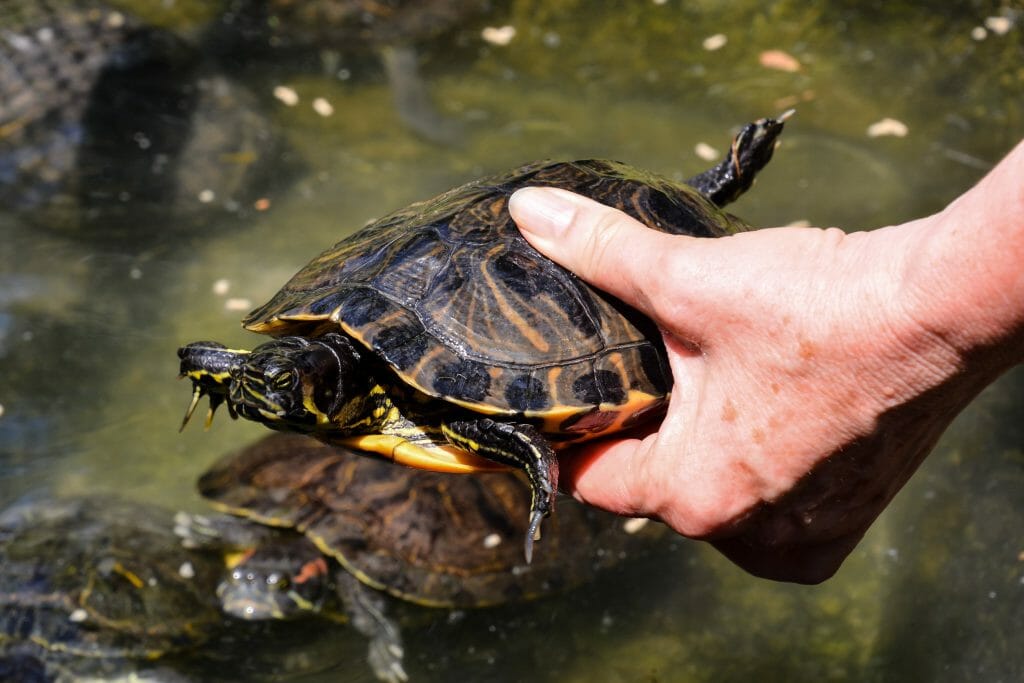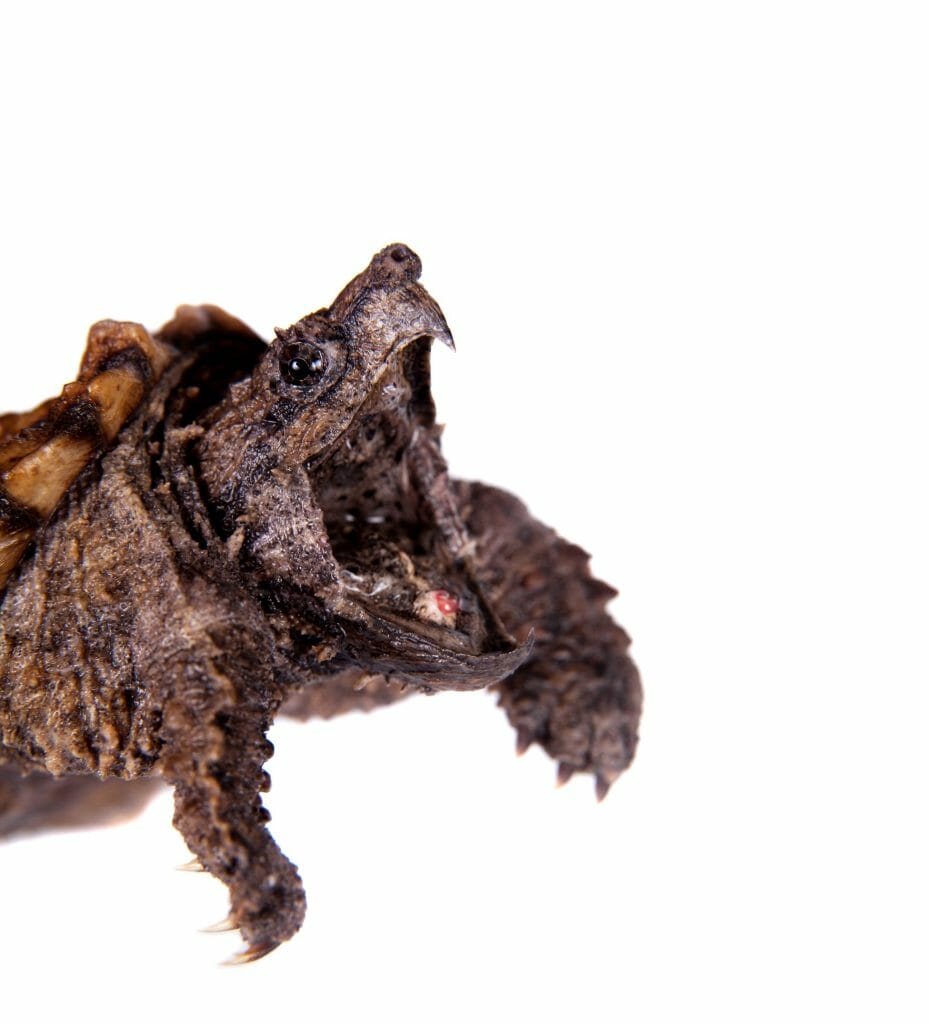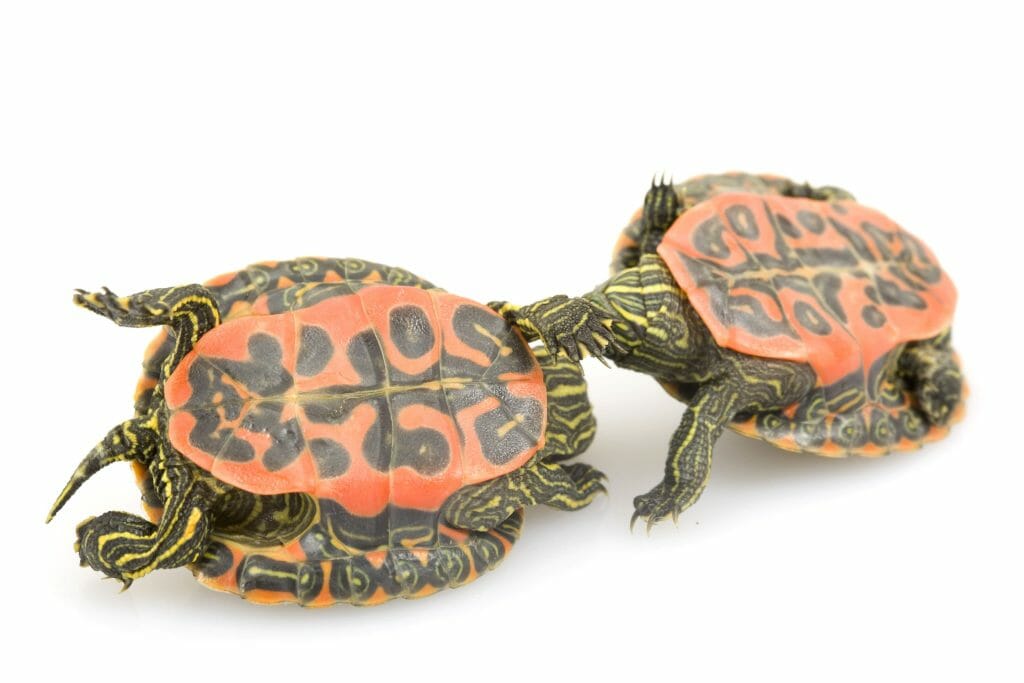Are Red-Eared Slider Turtles Aggressive: Commons Reasons and How to Avoid
Red-eared slider turtles can be quite territorial and aggressive. If handled roughly, a red-eared slider may snap at you defensively. The turtle is not known to bite other animals, but if they feel threatened, they can defend themselves.

Feed them live food rather than cooked meat, which will help to establish their personality and tame them over time. Make sure to provide them with plenty of nesting sites and hiding spots, and make noise when you approach them, so they know it’s not a threat. Handling red-eared slider turtles are a common challenge for new turtle owners, but with a bit of patience and care, they’ll soon become your new best friend!
Table of Contents
Reasons Why Red-Eared Slider Turtles Are Aggressive
In general, red-eared turtles are considered to be more aggressive vs. painted turtles. The main reason red-eared slider turtles get aggressive is to protect their territory and the eggs they lay – if someone tries to lay eggs in their territory, they’ll fight. Sliders typically only become aggressive during mating season or a nesting cycle. But, in the meantime, don’t be alarmed if you see them fighting – it’s just a sign of their territoriality.
Aquarium Is Too Small
If you have a turtle aquarium and the turtles don’t feel comfortable, there are some steps that you can take to try and make them more at home.
- Make sure the aquarium is big enough for all the turtles – if it isn’t, they will fight for space.
- Turtles are territorial by nature and will defend their space (and their food) from other turtles. If your aquarium doesn’t have ample room, try introducing new turtles slowly so there’s no conflict.
- You can also create separate areas for each turtle so they don’t get too close and conflict arises over territory or food items.
Competition Over Basking Spots and Food
When two turtles fight over a basking spot or food, it is usually over who gets to eat first. This can lead to bloodshed and stress for the turtles and the humans caring for them. If you have more than one turtle in your tank, give them enough space so they can’t get aggressive with each other. In addition, make sure their basking spots are rotated regularly so that all of them get an equal opportunity to bask in the sunlight every day.
Mating Rituals
When two turtles of the same species mate, it is often a contentious affair. Often, the smaller turtle will retreat and slowly get closer again to check if the other turtle is a potential partner. However, this process doesn’t always go smoothly – there are plenty of cases where tempers flare, and one turtle attacks and kills the other! This mating ritual is essential for turtles’ reproduction but can be deadly for them when things don’t go as planned.
Dominance Hierarchies
In turtle hierarchy, the dominant turtles rule over their subordinates and often engage in aggressive behavior towards each other during mating season. This is necessary for the turtles’ survival as it helps them protect themselves from other predators and competitors.
Species and Gender-Linked Aggression
There are many reasons why turtles might become aggressive towards each other – territory, mating, food, etc. When it comes to turtle aggression, males and females of the same species tend to be more aggressive than their counterparts of the opposite sex. This is usually related to territoriality and mating behavior – males want to claim territory, and females want to find a mate. Aggression can also occur during fights over food or nesting sites.
Stopping Your Red-Eared Slider Turtle From Being Aggressive

If you’re finding your slider turtle snapping at you or being generally aggressive, there are a few things you can do to try and remedy the situation.
- Make sure they have enough space – sliders love lots of room to run around.
- If their food dish is empty, try putting new food there daily.
- If their space is limited, get a climbing surface for them to use – this will help them explore their surroundings and reduce the chances of aggression.
- If the snapping doesn’t stop after following these tips, it may be time to seek professional help.
Red-eared slider turtles can take time to adjust to new environments and people, so be patient and give it time.
Enough Spacing
Turtles can be territorial and will defend their area aggressively. To prevent aggression, ensure enough space between you and the turtle. If the situation doesn’t improve after a few days, try to remove your turtle from its territory using humane methods such as snap traps or loud noises.
Create Female-Heavy Habitat
Creating female-heavy habitats for turtles can help reduce the turtle population’s aggression. One of the most common causes of aggressive behavior is overcrowding – when too many males compete for limited resources. By providing plenty of food and water dishes, nesting areas, hiding spots, and basking areas specifically designed for females, you can create a safe environment for your turtle.
Cleanliness is also vital in creating a healthy habitat – keep everything free from clutter or other potential dangers that could harm your turtle. In addition, make sure you regularly change the water dish and add fresh bedding to the enclosure to maintain humidity levels at optimum levels.
Feed in Different Areas
To keep your red-eared slider turtle happy and healthy, it’s essential to feed them in different areas of the house. This will prevent them from becoming bored and hence, destructive. Furthermore, ensure they have access to various food items, so they don’t get too used to just one kind of food. In addition, keep their enclosure clean so that other animals in the home do not feel threatened or attacked.
Overpopulation
If you have too many red-eared slider turtles in your yard, they will become aggressive and territorial. This can cause them to damage property or eat other animals. You can try to relocate them if this becomes necessary, but it’s best to do so slowly and in a way that doesn’t stress them out.
Place a Divider in the Tank
If your turtle becomes territorial, the best way to deal with the situation is by using a slider turtle divider. These dividers are large enough so that turtles cannot climb over them (and get stuck) and prevent other creatures from entering the tank. If you ever need to get rid of your turtle, do it safely and professionally – make sure not to stress out or harm your pet in any way!
Reasons Why Your Turtle Bites You
Some common reasons they might try to bite you are because they’re feeling threatened or their habitat is being disrupted. In most cases, these turtles are just trying to assert dominance over their environment and will stop biting once you take measures to discourage them. If the biting persists, consult with an animal handler who may be more experienced in dealing with aggressive turtles.
Putting Your Fingers Closer to Its Mouth
Sliders are usually docile creatures but can become aggressive when they feel threatened. This means that it is essential to be aware that sliders can bite if they feel provoked. For example, putting your fingers close to your mouth may interpret this as a threat and bite you in retaliation. So the best solution would be to keep your fingers away from its mouth at all times – even if it seems relaxed!
Feeling Threatened
If the slider feels threatened, it may lash out at anything that comes near – including you! So always take care when handling sliders as they can be aggressive toward humans if their territory is invaded. If you live in an area where slider turtles are common and find them invading your space, keep your turtle safe by providing it with enough space and ensuring no food or water is accessible outside its enclosure.
Stress
Turtles can get stressed out for various reasons, the most common of which are changes in their environment or being harassed by humans. Once you understand what’s causing the turtle stress, it is easier to handle the situation and prevent it from happening again. If turtles are constantly escaping their enclosures, ensure they have enough space to move around and that there isn’t anything blocking their path!
Poor Feeding
It may become aggressive if your slider is not getting the proper food intake. Poor feeding can also lead to various health problems, such as obesity and malnutrition. So, it’s essential to ensure you provide the right mix of vegetation, insects, and small animals, so your slider stays healthy and happy!
Protecting Its Eggs
When a red-eared slider turtle is threatened, it will protect its eggs by biting. If you are mishandling your turtle, it may react in this way. Always keep an eye on your turtle’s eggs when they are in the nest – do not touch them without first checking with your veterinarian. Make sure to handle your turtle gently and avoid picking it up by the tail – this can cause injury.
What to Do When a Red-Eared Slider Turtle Bites You?
Most bites don’t result in serious injury, but if you develop an infection, seek medical attention immediately. Always wear gloves when handling these turtles, even if you don’t think you’ll get bitten. Most infections from red-eared slider turtle bites are treated with antibiotics, though some require surgery to remove the turtle’s jawbone. So, be prepared for the possibility of being bitten by a slider turtle and know the risks involved.
List of the Most Aggressive Turtle Species
Sliders
Sliders can be pretty dangerous when defending their territory. Red-eared slider turtles are among the most aggressive turtle species- they can easily hurt people if provoked. If you’re ever faced with one of these turtles, try and scare it away by making loud noises or clapping your hands; sometimes, that’s enough to prompt the turtle into retreat.
Snapping Turtles
If you’re lucky to be near a snapping turtle in its natural habitat, prepare for some aggression! This turtle is known for being aggressive. Apart from biting hard, these reptiles can release a foul-smelling liquid when agitated.

So if you find yourself in an altercation with one, don’t try to pick it up – they are capable of biting very hard and could break your fingers! Better yet: back away slowly and avoid confrontation altogether. Regarding mating season, turtles can get quite territorial and aggressive. Make sure not to get involved if you spot them interacting aggressively – this tends to happen during the mating season when the male desires access to the female’s eggs or nestlings.
African Helmeted Turtles
African helmeted turtles are among the most aggressive turtle species and should not be taken home without first doing plenty of research. They can be territorial and attack anything near them – even other turtles! If you choose to keep an African Helmeted Turtle as a pet, ensure it is kept in a secure enclosure, so it doesn’t hurt or kill any other animals or people.

Snakenecks/Sidenecks
Snakenecks or side necks are the perfect names for these aggressive turtles. They have a powerful bite and can easily tear flesh from their victims- making them one of the most dangerous reptiles in the world. There are different types of snake necks, but the red-eared slider turtle is considered one of the most aggressive.

If you encounter this creature, it is best not to provoke it as it will likely attack without remorse. Make sure you know about its natural behavior, so you don’t get into trouble!
Soft-shell Turtles
Soft-shell turtles are among the most aggressive turtle species and should not be approached without caution. These reptiles can get defensive very quickly if they feel threatened, so it is best to stay away from them unless you know exactly what you’re doing. A few turtle species can be classified as aggressive – red-eared slider turtles and soft-shell turtles.
List of the Least Aggressive Turtle Species
Diamondback Terrapins
Diamondback terrapins are the most popular turtles pet owners choose, mainly because of their low-maintenance nature. They are usually easy to take care of and do not require a lot of interaction from their owner.
However, as with any turtle species, it is crucial to supervise them closely if they’re kept in an environment with other reptiles or small mammals. Diamondback terrapins generally make great pets and don’t require as much attention from their keeper as other turtle species.
Red-Bellied Cooters

If you’re afraid of reptiles, avoiding red-bellied cooters and other turtle species that are considered aggressive might be a good idea. Other non-aggressive options for pet turtles include the eastern box turtle and red-eared slider.
Box Turtles
Box turtles are one of the most popular pet reptiles in the world and for a good reason. They make great pets and can be easy to take care of. Here are a few tips to help you get started:
- Make sure you have a secure enclosure for your turtle – box turtles need plenty of space to roam around and should not be kept in small cages or isolation boxes.
- If you’re considering getting a red-eared slider turtle as a pet, it is best to go for the most miniature aggressive box turtle varieties, such as those with smooth shells (rather than spikes).
- Box turtles with spikes on their shell can become aggressive if they feel threatened or cornered, so it’s important to research which variety is suitable for you before making a purchase!
- Box turtles are gentle creatures who don’t attack humans but may take revenge if they feel threatened or cornered – make sure your turtle feels safe inside and outside its enclosure at all times!